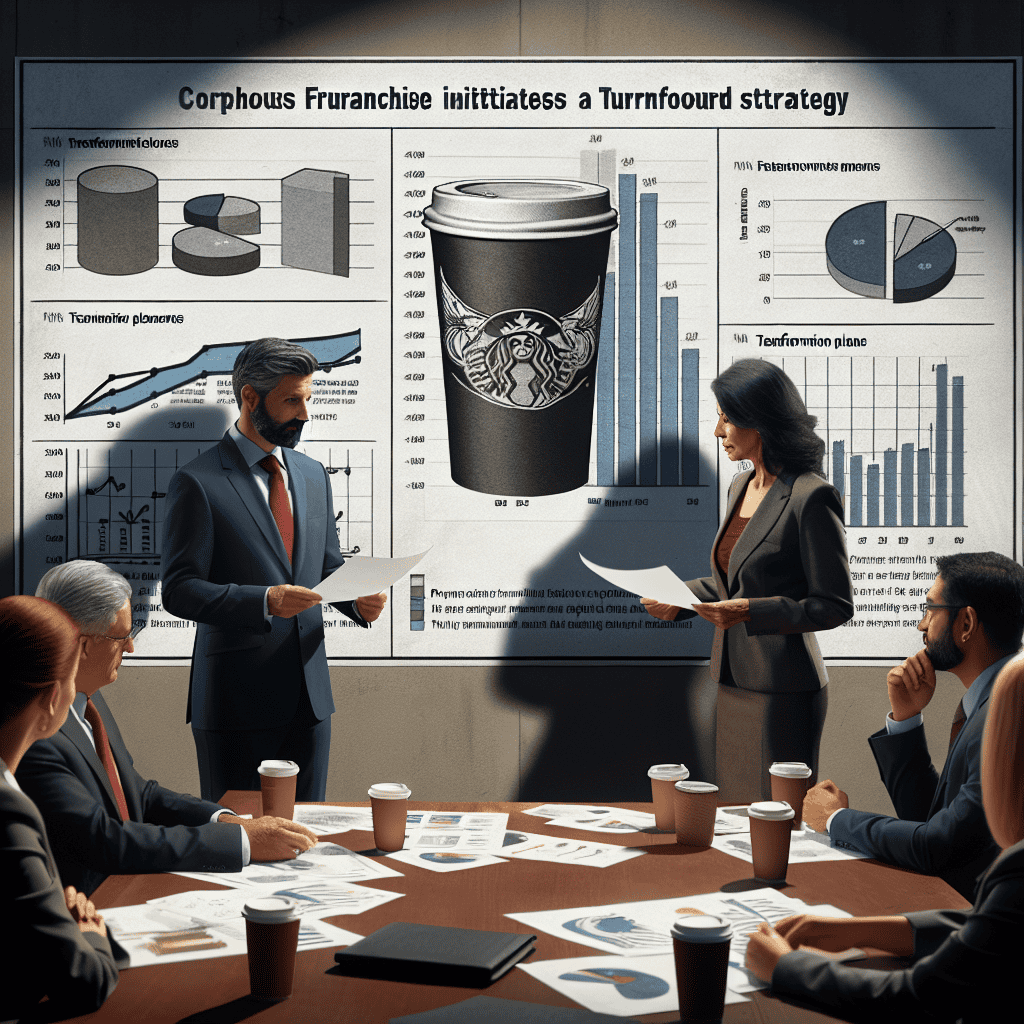“Brewing Change: Starbucks Charts a New Course with CEO’s Bold Turnaround Strategy”
Introduction
Starbucks has recently announced the withdrawal of its annual financial projections as the company embarks on a strategic turnaround under the leadership of its new CEO. This decision marks a significant shift in the company’s approach, reflecting the challenges and uncertainties it faces in the current market environment. The new CEO aims to revitalize the brand and address operational inefficiencies, focusing on long-term growth and sustainability. This move underscores Starbucks’ commitment to adapting to changing consumer preferences and competitive pressures, as it seeks to strengthen its position in the global coffee industry.
Impact Of Leadership Change On Starbucks’ Financial Projections
Starbucks, a global leader in the coffee industry, recently made headlines by withdrawing its annual financial projections, a move that has sparked considerable interest and speculation among investors and industry analysts. This decision comes on the heels of a significant leadership change, as the company welcomes its new CEO, Laxman Narasimhan. As Starbucks embarks on this new chapter, the implications of this leadership transition on its financial outlook are multifaceted and warrant a closer examination.
The withdrawal of annual projections is not a decision taken lightly by any corporation, particularly one as prominent as Starbucks. This action suggests a period of recalibration and strategic reassessment under Narasimhan’s leadership. It is not uncommon for new CEOs to reevaluate existing strategies and set new priorities, especially when aiming to implement a turnaround strategy. In this context, the decision to retract financial forecasts can be seen as a prudent step, allowing the new leadership to thoroughly assess the company’s current position and future direction without the constraints of previously set expectations.
Narasimhan’s appointment as CEO marks a pivotal moment for Starbucks, as he brings a fresh perspective and a wealth of experience from his previous roles in global consumer goods companies. His track record of driving growth and innovation is expected to play a crucial role in shaping Starbucks’ future. However, with this change comes the challenge of navigating the complexities of a highly competitive market, where consumer preferences are continually evolving, and economic uncertainties persist.
The impact of leadership change on Starbucks’ financial projections is further compounded by the broader economic environment. Rising inflation, supply chain disruptions, and fluctuating consumer spending patterns are factors that any new CEO must contend with. These external pressures necessitate a flexible and adaptive approach to business strategy, which may explain the decision to withhold specific financial targets at this juncture. By doing so, Starbucks can maintain agility in its operations and respond more effectively to unforeseen challenges and opportunities.
Moreover, Narasimhan’s focus on innovation and sustainability is likely to influence Starbucks’ strategic priorities moving forward. As consumers increasingly demand environmentally responsible practices, Starbucks’ commitment to sustainability could become a key differentiator in the market. This shift in focus may require significant investment and restructuring, further justifying the need to reassess financial projections. By aligning its business model with sustainable practices, Starbucks not only addresses consumer expectations but also positions itself for long-term growth in an increasingly eco-conscious market.
In addition to sustainability, enhancing the customer experience remains a central tenet of Starbucks’ strategy. Under Narasimhan’s leadership, the company is expected to leverage technology and digital platforms to create more personalized and engaging interactions with its customers. This emphasis on digital transformation could lead to new revenue streams and improved operational efficiencies, ultimately impacting the company’s financial performance.
In conclusion, the withdrawal of Starbucks’ annual projections under the new CEO’s leadership reflects a strategic pause to reassess and realign the company’s goals in light of both internal and external factors. While this decision may introduce a degree of uncertainty in the short term, it underscores a commitment to thoughtful and deliberate planning. As Narasimhan steers Starbucks through this transformative phase, the focus on innovation, sustainability, and customer experience is poised to shape the company’s trajectory, potentially leading to a more resilient and prosperous future.
Analyzing Starbucks’ Turnaround Strategy Under New CEO
Starbucks, a global leader in the coffee industry, has recently made headlines with its decision to withdraw its annual financial projections. This move comes as the company embarks on a new strategic direction under the leadership of its newly appointed CEO. The decision to retract these projections is not merely a financial maneuver but rather a significant component of a broader turnaround strategy aimed at revitalizing the brand and addressing the challenges it faces in an increasingly competitive market.
The new CEO, who brings a wealth of experience and a fresh perspective to the company, has identified several key areas that require immediate attention. By withdrawing the annual projections, Starbucks is signaling its commitment to flexibility and adaptability, allowing the company to focus on long-term growth rather than short-term financial targets. This approach is particularly pertinent given the dynamic nature of the global coffee market, where consumer preferences are continually evolving, and new competitors are emerging at a rapid pace.
One of the primary objectives of the new CEO’s strategy is to enhance the customer experience. Recognizing that customer satisfaction is paramount to the brand’s success, Starbucks is investing in innovative technologies and store redesigns to create a more personalized and engaging environment for its patrons. This includes the integration of digital tools that streamline the ordering process and offer tailored recommendations based on individual preferences. By leveraging technology in this manner, Starbucks aims to foster a deeper connection with its customers, thereby increasing brand loyalty and driving repeat business.
In addition to improving the customer experience, the new strategy places a strong emphasis on sustainability and ethical sourcing. Starbucks has long been a proponent of responsible business practices, and under the new leadership, these efforts are being intensified. The company is committed to reducing its environmental footprint by implementing more sustainable practices across its supply chain and operations. This includes initiatives such as reducing waste, conserving water, and sourcing coffee beans from farms that adhere to ethical and sustainable farming practices. By prioritizing sustainability, Starbucks not only addresses the growing consumer demand for environmentally conscious products but also reinforces its position as a leader in corporate social responsibility.
Furthermore, the new CEO is focused on expanding Starbucks’ global footprint. While the company already boasts a significant international presence, there are still untapped markets that present lucrative opportunities for growth. The strategy involves a careful analysis of these markets to identify potential entry points and tailor offerings to meet local tastes and preferences. This targeted expansion is expected to bolster Starbucks’ global brand presence and contribute to its long-term financial success.
In conclusion, Starbucks’ decision to withdraw its annual projections is a strategic move that underscores the company’s commitment to a comprehensive turnaround strategy under its new CEO. By prioritizing customer experience, sustainability, and global expansion, Starbucks is positioning itself to navigate the challenges of the modern coffee market effectively. As the company implements these initiatives, it remains to be seen how they will impact its financial performance in the coming years. However, with a clear vision and a focus on long-term growth, Starbucks is poised to strengthen its position as a leader in the global coffee industry.
Challenges Facing Starbucks Amidst Withdrawal Of Annual Projections
Starbucks, a global leader in the coffeehouse industry, recently made headlines by withdrawing its annual financial projections, a move that has sparked considerable discussion among investors and industry analysts. This decision comes as the company navigates a complex landscape of challenges, both internal and external, under the leadership of its new CEO. The withdrawal of these projections is not merely a financial recalibration but a strategic pivot aimed at addressing the multifaceted issues that Starbucks currently faces.
One of the primary challenges confronting Starbucks is the evolving consumer behavior in the post-pandemic world. As remote work becomes more prevalent, the traditional morning coffee rush has diminished, leading to a shift in peak business hours. This change necessitates a reevaluation of store operations and staffing, which in turn impacts financial forecasting. Moreover, the rise of digital platforms and delivery services has altered the way consumers interact with the brand, requiring Starbucks to invest heavily in technology and digital infrastructure to meet these new demands.
In addition to changing consumer habits, Starbucks is grappling with significant supply chain disruptions. The global supply chain crisis, exacerbated by geopolitical tensions and the lingering effects of the pandemic, has led to increased costs and delays in the procurement of essential goods. These disruptions have not only affected the availability of key ingredients but have also inflated operational costs, further complicating the company’s financial outlook. Consequently, the unpredictability of these factors has made it increasingly difficult for Starbucks to provide accurate annual projections.
Furthermore, Starbucks is facing heightened competition from both established coffee chains and emerging local players. As the market becomes more saturated, differentiating the brand and maintaining customer loyalty have become critical challenges. Competitors are aggressively expanding their offerings and enhancing customer experiences, compelling Starbucks to innovate continuously. This competitive pressure necessitates substantial investment in product development and marketing, which can strain financial resources and impact profitability.
Internally, Starbucks is undergoing a significant leadership transition with the appointment of a new CEO. This change at the helm brings both opportunities and challenges. While new leadership can infuse fresh perspectives and strategies, it also requires time to implement changes and gain the confidence of stakeholders. The new CEO’s turnaround strategy is expected to focus on revitalizing the brand, optimizing operations, and enhancing sustainability initiatives. However, these strategic shifts may take time to yield tangible results, adding another layer of complexity to the company’s financial planning.
In light of these challenges, Starbucks’ decision to withdraw its annual projections can be seen as a prudent move. By doing so, the company acknowledges the current uncertainties and allows itself the flexibility to adapt to rapidly changing conditions. This approach enables Starbucks to focus on long-term strategic goals rather than being constrained by short-term financial targets. It also signals to investors and stakeholders that the company is committed to navigating these challenges with agility and foresight.
In conclusion, Starbucks’ withdrawal of its annual projections underscores the myriad challenges it faces in today’s dynamic environment. From shifting consumer behaviors and supply chain disruptions to intensified competition and leadership transitions, the company is navigating a complex web of issues. As the new CEO implements a turnaround strategy, Starbucks is poised to adapt and evolve, ensuring its continued relevance and success in the global coffee market.
The Role Of Strategic Planning In Starbucks’ Future Success

Starbucks, a global leader in the coffee industry, has recently made headlines by withdrawing its annual financial projections, a move that has sparked considerable discussion among investors and industry analysts. This decision comes as the company’s new CEO embarks on a comprehensive turnaround strategy aimed at revitalizing the brand and ensuring its long-term success. The withdrawal of these projections underscores the critical role that strategic planning plays in navigating the complexities of the modern business environment, particularly for a company as expansive and influential as Starbucks.
The decision to retract annual projections is not one taken lightly, as it can lead to uncertainty among stakeholders. However, it also reflects a commitment to adaptability and a willingness to recalibrate in response to evolving market conditions. This strategic pivot is indicative of a broader trend in corporate governance, where flexibility and responsiveness are increasingly valued over rigid adherence to predetermined plans. For Starbucks, this approach is particularly pertinent given the dynamic nature of the global coffee market, which is influenced by factors ranging from consumer preferences to supply chain disruptions.
Under the leadership of its new CEO, Starbucks is poised to implement a series of strategic initiatives designed to enhance operational efficiency and drive growth. These initiatives are expected to focus on several key areas, including digital innovation, sustainability, and customer experience. By leveraging technology, Starbucks aims to streamline its operations and offer a more personalized experience to its customers. This includes expanding its mobile ordering capabilities and enhancing its loyalty program, both of which are crucial in maintaining a competitive edge in an increasingly digital marketplace.
Moreover, sustainability remains a cornerstone of Starbucks’ strategic planning. The company has long been committed to ethical sourcing and environmental stewardship, and these values are expected to be further integrated into its business model. By prioritizing sustainable practices, Starbucks not only addresses the growing consumer demand for environmentally responsible products but also positions itself as a leader in corporate social responsibility. This alignment of business objectives with societal values is essential for building brand loyalty and ensuring long-term success.
In addition to these strategic priorities, Starbucks is also focusing on enhancing the in-store experience. As the coffeehouse culture continues to evolve, creating a welcoming and engaging environment is paramount. This involves not only the physical layout and design of stores but also the quality of service provided by baristas. By investing in employee training and development, Starbucks aims to foster a culture of excellence that resonates with customers and reinforces its brand identity.
While the withdrawal of annual projections may initially seem like a step back, it is, in fact, a strategic maneuver that allows Starbucks to recalibrate and align its goals with the current market landscape. This decision highlights the importance of strategic planning in navigating uncertainty and underscores the need for businesses to remain agile and forward-thinking. As Starbucks embarks on this new chapter under the guidance of its CEO, the emphasis on strategic planning will undoubtedly play a pivotal role in shaping the company’s future success. By focusing on innovation, sustainability, and customer experience, Starbucks is well-positioned to not only weather the challenges of the present but also to thrive in the years to come.
How Starbucks’ New Leadership Aims To Revitalize The Brand
Starbucks, a global leader in the coffee industry, has recently made a significant strategic shift under the guidance of its new CEO, who has decided to withdraw the company’s annual projections. This move marks a pivotal moment in the company’s history, as it seeks to revitalize its brand and adapt to the rapidly changing market dynamics. The decision to retract annual forecasts is not merely a financial maneuver but a broader indication of the new leadership’s commitment to a comprehensive turnaround strategy.
The new CEO, who took the helm amid a challenging economic landscape, has emphasized the need for flexibility and adaptability in the face of evolving consumer preferences and global uncertainties. By withdrawing annual projections, Starbucks aims to focus on long-term growth and sustainability rather than short-term financial targets. This approach allows the company to allocate resources more effectively and respond swiftly to market changes, thereby enhancing its competitive edge.
In addition to this strategic shift, the new leadership is prioritizing innovation and customer experience as key pillars of the turnaround strategy. Recognizing the importance of staying relevant in a highly competitive market, Starbucks is investing in technology and digital platforms to enhance customer engagement. This includes expanding its mobile app capabilities, improving the efficiency of its drive-thru services, and exploring new delivery options. By leveraging technology, Starbucks aims to create a seamless and personalized experience for its customers, thereby fostering brand loyalty and driving growth.
Moreover, the new CEO is committed to strengthening Starbucks’ commitment to sustainability and social responsibility. In recent years, consumers have become increasingly conscious of the environmental and social impact of their purchasing decisions. To address these concerns, Starbucks is intensifying its efforts to reduce its carbon footprint, promote ethical sourcing, and support local communities. These initiatives not only align with the company’s values but also resonate with its customer base, which increasingly prioritizes sustainability in their consumption choices.
Furthermore, the turnaround strategy includes a renewed focus on product innovation and diversification. Starbucks is exploring new product lines and expanding its menu offerings to cater to a broader range of tastes and preferences. This includes introducing plant-based options, experimenting with new flavors, and tapping into emerging trends such as cold brew and nitro coffee. By diversifying its product portfolio, Starbucks aims to attract new customers while retaining its existing loyal clientele.
The new leadership is also placing a strong emphasis on employee engagement and development. Recognizing that its workforce is a critical asset, Starbucks is investing in training programs, career development opportunities, and initiatives to enhance employee well-being. By fostering a positive and inclusive work environment, the company aims to boost employee morale and productivity, which in turn contributes to improved customer service and overall business performance.
In conclusion, Starbucks’ decision to withdraw its annual projections under the new CEO’s leadership signifies a bold and strategic move towards revitalizing the brand. By focusing on long-term growth, innovation, sustainability, and employee engagement, the company is positioning itself to navigate the challenges of the modern market and secure its place as a leader in the global coffee industry. As Starbucks embarks on this transformative journey, it remains committed to delivering exceptional experiences to its customers while upholding its core values and principles.
Investor Reactions To Starbucks’ Shift In Financial Guidance
Starbucks’ recent decision to withdraw its annual financial projections has sparked a wave of reactions among investors, reflecting both concern and cautious optimism. This strategic move comes as the company’s new CEO embarks on a comprehensive turnaround strategy aimed at revitalizing the global coffee giant. The decision to retract guidance is not entirely unprecedented in the corporate world, yet it invariably sends ripples through the investment community, prompting a reevaluation of the company’s future prospects.
The withdrawal of financial projections is often perceived as a red flag, suggesting potential instability or unforeseen challenges. In the case of Starbucks, this action has been interpreted by some investors as an indication of the complexities involved in the new CEO’s strategic overhaul. The absence of clear financial targets can create uncertainty, leading to volatility in stock prices as investors grapple with the lack of concrete benchmarks to assess the company’s performance. Consequently, some stakeholders may choose to adopt a wait-and-see approach, holding off on making significant investment decisions until more clarity emerges.
However, it is essential to consider the broader context in which this decision has been made. The new CEO’s turnaround strategy is designed to address several critical areas, including operational efficiency, customer experience, and digital innovation. By focusing on these key aspects, the company aims to strengthen its competitive position in an increasingly dynamic market. The decision to withdraw annual projections can be seen as a strategic move to provide the leadership team with the flexibility needed to implement these changes without the pressure of meeting pre-set financial targets.
Moreover, the new CEO’s approach has been characterized by a commitment to transparency and open communication with investors. By clearly articulating the rationale behind the withdrawal of projections, the leadership seeks to build trust and foster a collaborative relationship with stakeholders. This transparency is crucial in maintaining investor confidence, as it demonstrates a willingness to confront challenges head-on and adapt to evolving market conditions.
In addition to operational improvements, Starbucks is also focusing on expanding its global footprint, particularly in emerging markets where growth potential remains significant. The company’s efforts to tailor its offerings to local tastes and preferences underscore its commitment to capturing new customer segments and driving long-term growth. This strategic expansion, coupled with a renewed emphasis on sustainability and social responsibility, aligns with evolving consumer expectations and positions Starbucks as a forward-thinking brand.
While the withdrawal of financial projections may initially unsettle some investors, it is important to recognize the potential benefits of this approach. By prioritizing strategic flexibility and long-term growth over short-term financial targets, Starbucks is positioning itself to navigate the complexities of the modern business landscape more effectively. This shift in focus may ultimately yield positive results, as the company adapts to changing consumer behaviors and leverages new opportunities for innovation.
In conclusion, the investor reactions to Starbucks’ shift in financial guidance reflect a nuanced understanding of the challenges and opportunities facing the company. While uncertainty may persist in the short term, the new CEO’s comprehensive turnaround strategy offers a promising path forward. By embracing transparency, operational excellence, and global expansion, Starbucks is poised to strengthen its market position and deliver sustainable value to its shareholders. As the company embarks on this transformative journey, investors will be closely monitoring its progress, eager to see how these strategic initiatives unfold in the months and years ahead.
Comparing Starbucks’ Current Strategy With Past Turnaround Efforts
Starbucks, a global leader in the coffee industry, has recently made headlines by withdrawing its annual projections, a move that signals a significant shift in its strategic approach under the leadership of its new CEO. This decision marks a departure from the company’s previous practices and invites comparisons with past turnaround efforts. Historically, Starbucks has navigated various challenges by implementing strategic changes, and examining these past efforts provides valuable insights into the current strategy.
In the early 2000s, Starbucks faced a period of stagnation, prompting then-CEO Howard Schultz to return to the helm. Schultz’s strategy focused on revitalizing the brand by enhancing the customer experience and innovating the product line. This included the introduction of new beverages and the redesign of store layouts to create a more inviting atmosphere. Schultz’s approach was characterized by a clear vision and a commitment to quality, which ultimately led to a successful turnaround and a resurgence in the company’s growth.
Fast forward to the present, and Starbucks finds itself at another crossroads. The decision to withdraw annual projections under the new CEO’s leadership suggests a willingness to embrace flexibility and adaptability in the face of evolving market conditions. This move allows the company to focus on long-term strategic goals rather than being constrained by short-term financial targets. By doing so, Starbucks aims to navigate the complexities of a rapidly changing global market, characterized by shifting consumer preferences and increased competition.
The current strategy also emphasizes digital transformation, a critical component in today’s business landscape. Starbucks is investing heavily in technology to enhance its digital platforms, improve customer engagement, and streamline operations. This focus on digital innovation is reminiscent of past efforts to leverage technology for growth, such as the introduction of the Starbucks mobile app and the expansion of its loyalty program. These initiatives have historically driven customer loyalty and increased sales, and the new CEO appears to be building on this foundation to further integrate technology into the company’s operations.
Moreover, the new strategy places a strong emphasis on sustainability and social responsibility, aligning with broader industry trends and consumer expectations. Starbucks has committed to reducing its environmental footprint and supporting ethical sourcing practices. This focus on sustainability is not entirely new, as the company has long been a proponent of ethical business practices. However, the current strategy seeks to elevate these efforts, positioning Starbucks as a leader in corporate responsibility and appealing to a growing segment of environmentally conscious consumers.
In comparing the current strategy with past turnaround efforts, it is evident that while the core principles of innovation, customer focus, and quality remain consistent, the new CEO is adapting these principles to address contemporary challenges. The decision to withdraw annual projections reflects a strategic pivot towards long-term growth and resilience, allowing Starbucks to remain agile in an unpredictable market. By prioritizing digital transformation and sustainability, the company is not only responding to current trends but also setting the stage for future success.
In conclusion, Starbucks’ current strategy under its new CEO represents a thoughtful evolution of past turnaround efforts. By learning from history while embracing new opportunities, Starbucks is positioning itself to navigate the complexities of the modern business environment. As the company moves forward, its ability to balance tradition with innovation will be crucial in maintaining its status as a global coffee powerhouse.
Q&A
1. **What prompted Starbucks to withdraw its annual projections?**
Starbucks withdrew its annual projections due to the initiation of a turnaround strategy by its new CEO, which introduced uncertainties in the company’s short-term performance outlook.
2. **Who is the new CEO of Starbucks?**
The new CEO of Starbucks is Laxman Narasimhan.
3. **What is the main focus of the new CEO’s turnaround strategy?**
The main focus of the new CEO’s turnaround strategy is to revitalize the company’s operations, enhance customer experience, and drive long-term growth.
4. **How has the market reacted to Starbucks withdrawing its projections?**
The market reaction to Starbucks withdrawing its projections has been mixed, with some investors concerned about short-term uncertainties while others are optimistic about the potential long-term benefits of the new strategy.
5. **What are some key components of the turnaround strategy?**
Key components of the turnaround strategy include improving store efficiency, investing in employee training, expanding digital capabilities, and enhancing product offerings.
6. **How does the new strategy impact Starbucks’ financial outlook?**
The new strategy impacts Starbucks’ financial outlook by creating short-term uncertainty, leading to the withdrawal of annual projections, but it aims to position the company for sustainable long-term growth.
7. **What challenges does Starbucks face in implementing the turnaround strategy?**
Challenges in implementing the turnaround strategy include managing operational disruptions, aligning the workforce with new initiatives, and maintaining customer loyalty during the transition period.
Conclusion
Starbucks’ decision to withdraw its annual projections signals a strategic pivot under the leadership of its new CEO, who is focused on implementing a comprehensive turnaround strategy. This move reflects the company’s acknowledgment of the challenges it faces and its commitment to recalibrating its business operations to drive long-term growth. By not providing specific financial forecasts, Starbucks is allowing itself the flexibility to adapt to changing market conditions and internal restructuring efforts. The new CEO’s approach suggests a focus on revitalizing the brand, enhancing operational efficiency, and potentially exploring new avenues for revenue generation. This strategic shift aims to position Starbucks for sustainable success in a competitive and evolving global market.





